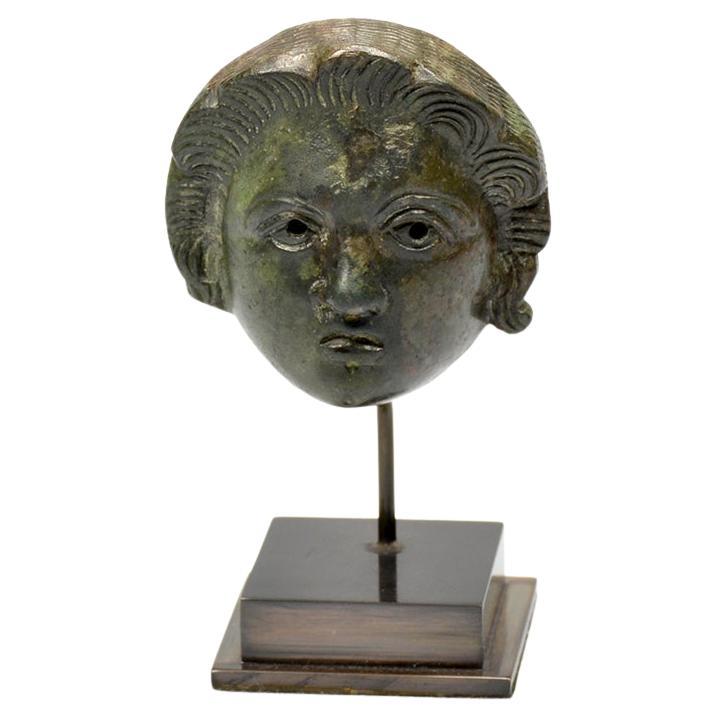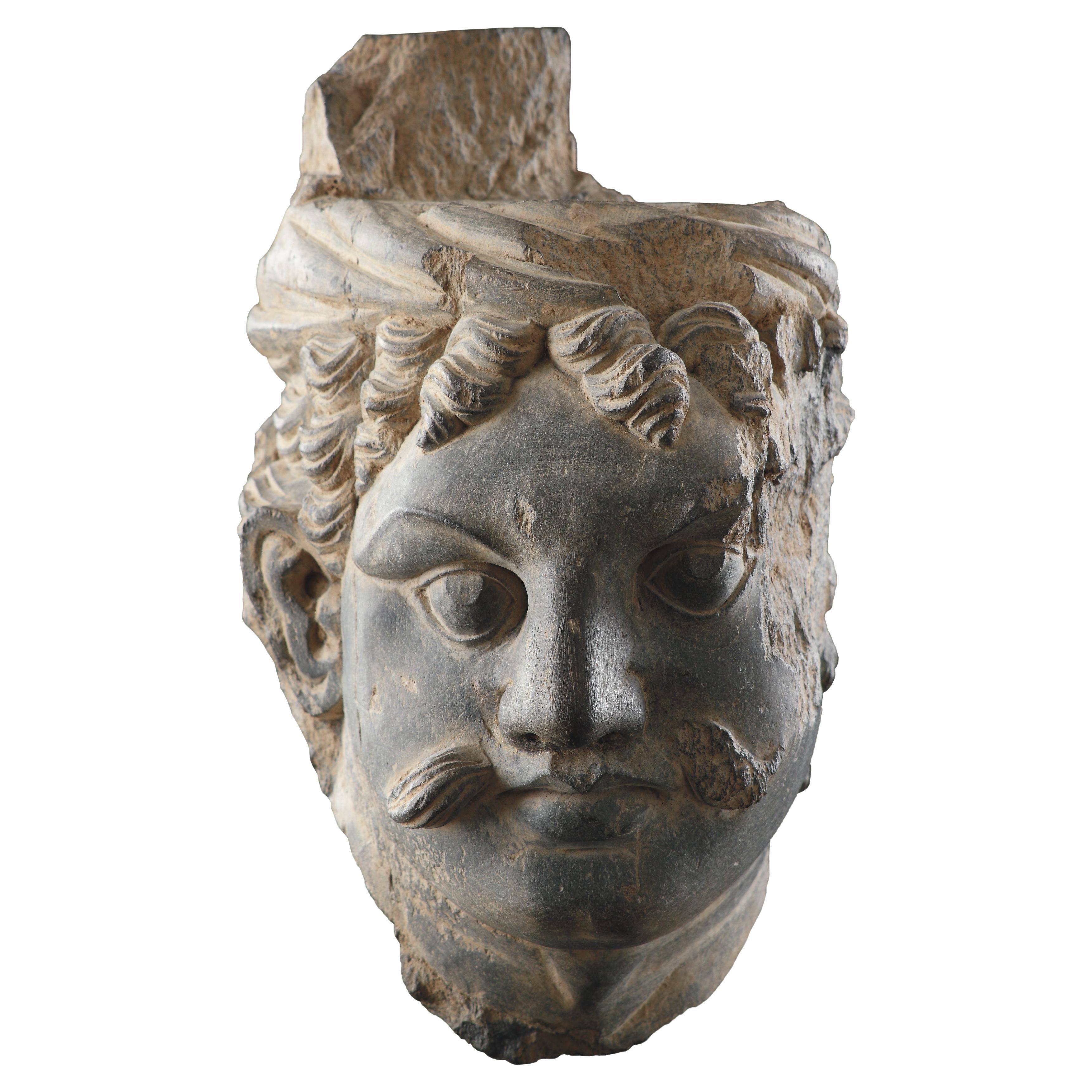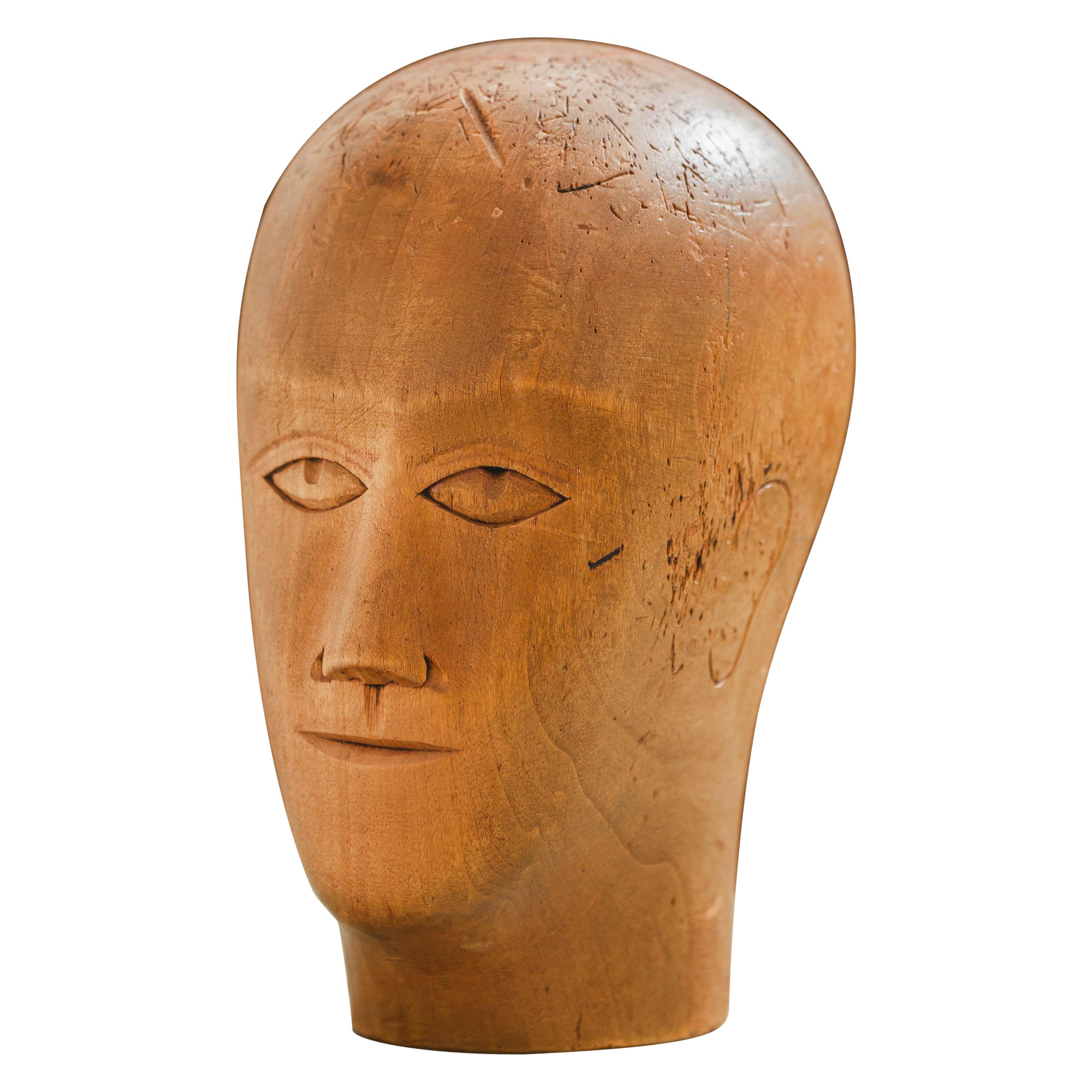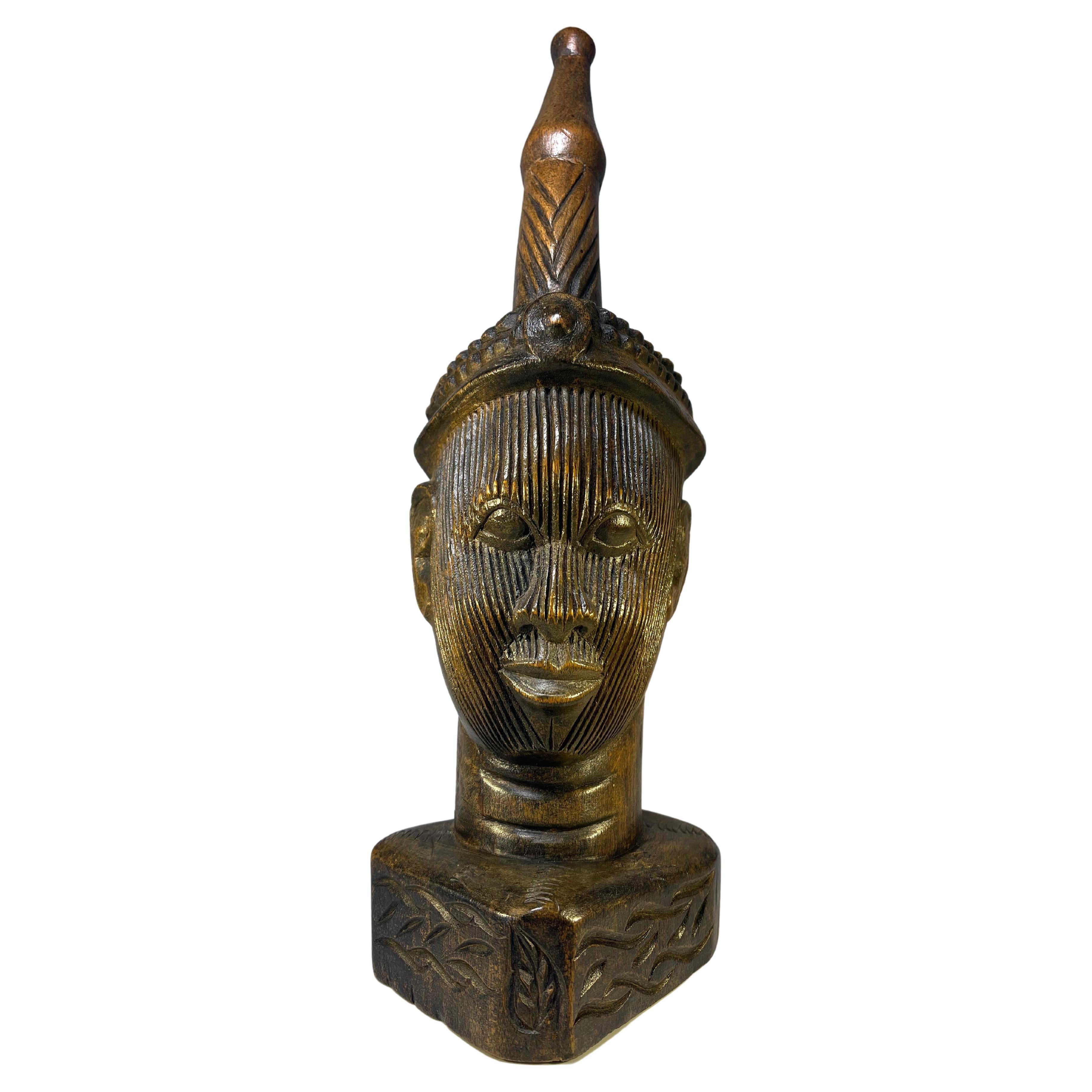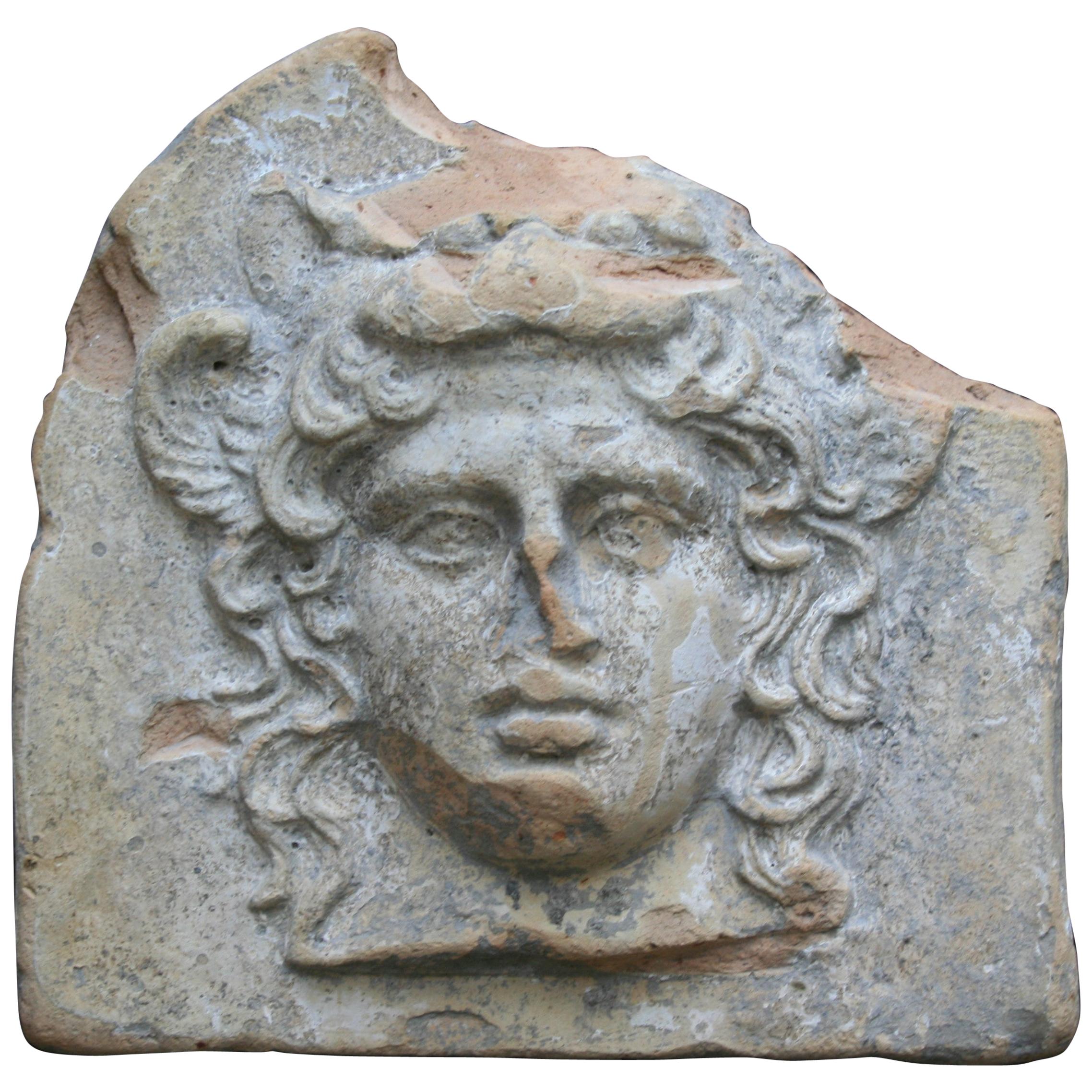Items Similar to South Arabian Head of a Woman
Want more images or videos?
Request additional images or videos from the seller
1 of 7
South Arabian Head of a Woman
About the Item
A female head finely carved from evenly-coloured cream alabaster. The face features a strong chin, high rounded cheekbones, and large elliptical eyes deeply inset for inlays. The remains of the nose indicate that it was long, thin, and roughly triangular in form. A small, round mouth sits just below the nose. Deeply incised eyebrows follow the shape of the eyes, which are framed by unusual grooved canthi on either side, possibly to represent cosmetic eye paint. The supraorbital margins above the eyes are deeply carved, while the carving below the eyes is more subtle, smoothing the sockets into the rounded cheeks. The ears are formed from two arcs and a central sphere, and both lobes are pierced for earrings. The long hair frames the face below the ears, and is carved to create a rougher texture. There is a stock sticker on the back of the neck. A fragment of the right shoulder remains. This suggests that the head was part of a larger sculpture, possibly a full figure (though this seems unlikely due to its relatively large scale) or, more likely, a bust.
This head is stylistically aligned with those found at Timna, the capital of the ancient Yemeni kingdom of Qataban, which existed from the 1st millennium BC until the late 1st or 2nd centuries AD. Timna served as an important hub of the Incense Route, the camel caravan that transported incense from Arabia and India to ports on the Mediterranean Sea. Roman author and philosopher Pliny the Elder (23/24-79 AD) described Timna as a busy city with around 65 temples. Excavations in 1950 and 1951 by Wendell Phillips and his team unearthed several sites in the city, including the South Gate, private residences, a structure identified as a temple complex, and the necropolis. The alabaster heads were found in the vicinity of the necropolis, known as ?ayd ibn ‘Aqil. A further head was discovered in 1962 by a British officer stationed in Aden. The heads are all roughly carved on the reverse and often squared off at the top and back, suggesting that they were designed to be placed within niches in a shrine; several of the sculptures were found together within the antechamber of a crypt.
Published
Catalogue of Egyptian, Greek, Roman and Near Eastern Antiquities, Indian, African and Oceanic Art, Sotheby's, London, , 29th April 1963, Lot 86.
Sculpture from South Arabia, exh. cat., Gimpel Fils, London, December 1970-January 1971, no. 10
Provenance
Sold at: Sotheby's, London, April 29th, 1963, Lot 86.
With Gimpel Fils, London, acquired from the above sale (accompanied by old illustrated stock card).
Private Collection, UK, acquired from the above 18th March 2018.
ALR: S00229349, with IADAA Certificate, this item has been checked against the Interpol database.
- Dimensions:Height: 8.67 in (22 cm)Width: 4.34 in (11 cm)Depth: 3.94 in (10 cm)
- Materials and Techniques:
- Place of Origin:
- Period:
- Date of Manufacture:circa 1st - 3rd century A.D.
- Condition:Minor losses. As shown. Note losses to facial features. Proper left ear better preserved than proper right one. Surface has high polish. Head rests on modern metal base.
- Seller Location:London, GB
- Reference Number:1stDibs: LU5517234196192
About the Seller
5.0
Vetted Seller
These experienced sellers undergo a comprehensive evaluation by our team of in-house experts.
Established in 1910
1stDibs seller since 2020
- ShippingRetrieving quote...Ships From: London, United Kingdom
- Return PolicyThis item cannot be returned.
More From This SellerView All
- Statuette of the Goddess NeithLocated in London, GBBronze statue of the goddess Neith, striding, her left foot extended forward. Her left hand is extended forward and formally held a papyrus sceptre, a fragmentary ankh is visible in her right hand. She wears a close-fitting sheath dress, incised with a broad usekh collar, and carefully engraved bracelets and armlets. On her head is the Red Crown of Lower Egypt, decorated with vertical striations and restored spiral and spire. Her face is finely molded, with a broad upturned nose and electrum-overlaid eyes and eyebrows. Neith was one of the earliest recorded gods in the Egyptian pantheon, worshipped from early in the Predynastic era through to the arrival of Roman rule. A war goddess and goddess of weaving, she was the patron goddess of the Red Crown of Lower Egypt and the city of Zau (Sais, in the 5th Nome of Lower Egypt) in the Delta. A powerful and popular goddess, she was, according to the Iunyt (Esna) cosmology, the creator of the world and the mother of the sun, Ra. This made her the mother of all of the gods, who often came to her to settle their disputes. Her symbols are the bow and arrows and a sword and shield as a war goddess, a weaving shuttle as a funerary goddess, and the Red Crown of Lower Egypt as the goddess of creation and mother goddess. She is usually depicted as a woman wearing the Red Crown of Lower Egypt, however, she is occasionally depicted as a cow in connection with her role as the mother of Ra. The use of electrum, a naturally occurring alloy of gold and silver sometimes called ‘green-gold’, for the eyes speaks to the high status of the object. Electrum had been used by the Egyptians since at least the 3rd millennium B.C., but, give its rarity, was reserved for the most expensive and important objects. Most electrum used in Egypt was imported from Nubia, though some was found there. Published: Parke-Bernet Galleries, New York, February 25th, 1971, no. 70, illus. Sotheby’s, New York, June 5th, 1999, no. 31, illus. David Aaron Ltd...Category
Antique 15th Century and Earlier Egyptian Egyptian Antiquities
MaterialsBronze
- Two Glass Inlay PairsLocated in London, GBTwo pairs of two halves from the same bar, finely detailed, with pointed ears and eyebrows, opaque yellow face, opaque red on the mouth, nose, eyes and ears, translucent cobalt blue edges to the mouth, nose and ears, with translucent emerald green leaves above and between the translucent cobalt blue brows and eye line, translucent pink pupils, with translucent cobalt blie and opaque white snake scales below the face, in translucent cobalt blue matrix, cut in the lower part of a cartouche design. These rare heads might represent the Agathos Daimon, the tutelary deity of Alexandria, who was also identified with Serapis, the male counterpart of Isis-Thermouthis (who in turn was a graecisized form of the early snake harvest goddess Renenutet). In a statue of Isis-Thermouthis in Alexandria museum (no. 25773, ex-collection King Farouk I), reproduced in Gotten, Pharaonen, no. 151, the snake goddess...Category
Antique 15th Century and Earlier Egyptian Antiquities
MaterialsGlass
- Anglo-Saxon Hanging BowlLocated in London, GBA very rare and near-complete copper-alloy hanging bowl and associated fittings. Crafted from a single sheet of bronze, the body of the bowl is curved, with a slightly recessed lip. ...Category
Antique 15th Century and Earlier English Antiquities
MaterialsBronze
- Megalithic StelaLocated in London, GBA tall anthropomorphic stele of carved granite, divided into two distinct regions of the body and face. The body is a single unarticulated block, but the facial features are outlined...Category
Antique 15th Century and Earlier European Antiquities
MaterialsGranite
- Bronze SirenLocated in London, GBSirens were dangerous bird-like females who tempted sailors with their hauntingly beautiful song. In Homer’s Odyssey (XII, 39) Odysseus and his sailors were warned about the lethal c...Category
Antique 15th Century and Earlier Greek Classical Greek Antiquities
MaterialsBronze
- Bronze HoardLocated in London, GBDagger L: 27.8 cm, Luniform bronze, possibly a belt buckle L: 10.8 cm, Shield-shaped bronze with a point Diam: 6.5 cm, Pommel Diam: 3.7 cm, Violin-bow brooch L: 17.5 cm, P-Shape...Category
Antique 15th Century and Earlier European Classical Roman Antiquities
MaterialsBronze
You May Also Like
- A Roman bronze head attachment of a youthLocated in UTRECHT, UTA finely detailed appliqué with the face of a youth, wavy hair framing the circular face, with well defined eyes, pierced for inlays. 5.5 cm (h) Provenance: Ex Jean-Phillipe Mari...Category
Antique 15th Century and Earlier Italian Classical Roman Antiquities
MaterialsBronze
- A Finely Carved Gandhara Head of ‘Atlas’Located in London, GBA Finely Carved Gandhara Head of ‘Atlas’ Grey schist India 3rd - 4th Centuries AD SIZE: 19cm high, 11cm wide, 12.5cm deep - 7½ ins high, 4¼ ins wide, 5 ins deep References Pratap...Category
Antique 15th Century and Earlier Indian Antiquities
MaterialsSchist
- Turn of The Century Sycamore Milliners HeadLocated in Arundel, GBRef: 125280 Sycamore milliner's head with hand carved features and signs of original use. Belgium circa 1900 Measurements: H: 23cm (9.1") W: 12.5cm (4.9") D: 15cm (5.9")Category
Antique Early 1900s Belgian Antiquities
MaterialsSycamore
- Framed Collection of Mesoamerican Pre-Classic Period Sculptures & Arrow HeadsLocated in New York, NYIncredible collection of pre-columbian clay sculptures / figures / statues / pottery, mounted and framed. The pieces date from the pre-classic (Formative) period of Meso-American cul...Category
Antique 15th Century and Earlier North American Pre-Columbian Figurative...
MaterialsHardwood, Precious Stone, Clay
- Olokun Head, Kingdom of Ife, Western Nigeria Hand Carved HardwoodLocated in Rothley, LeicestershireFascinating detailed Olokun head from the Kingdom of Ife in Western Nigeria. Hand carved hardwood face with almond shaped eyes, neck creases and astounding facial incisions Circa 1...Category
Late 20th Century Beninese Folk Art Antiquities
MaterialsHardwood
- Ancient Greek Terracotta Antefix in Form of the Head of Artemis Bendis, TarantoLocated in Antwerp, BEAncient Greek mould-made terracotta antefix decorated with the female head of the Goddess Artemis Bendis. Western Greek, Italy, Taranto, early 4th century BC. Two small feathered win...Category
Antique 15th Century and Earlier Italian Classical Greek Antiquities
MaterialsCeramic
Recently Viewed
View AllMore Ways To Browse
Indian Alabaster Sculpture
Roman Bust 2nd Century
Indian Temple Fragment
Indian Incense
Wendell Phillips
Alabaster Temple
Thai Brass Loveseats
Thai Plastic Loveseats
Tiffany Co Silver Tea And Coffee Service
Tiffany Coffe Tea Service
Tiffany Cup Saucer
Tiffany Southampton
Tiger Lumbar Pillow
Tiger Lumbar
Tonala Pitcher
Transitional Headboard
Tribal Evil Eye Bracelet
Venetian Crystal 8 Light Chandelier
